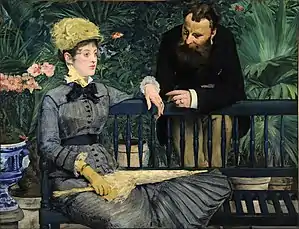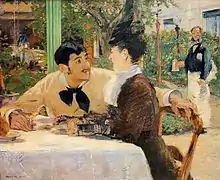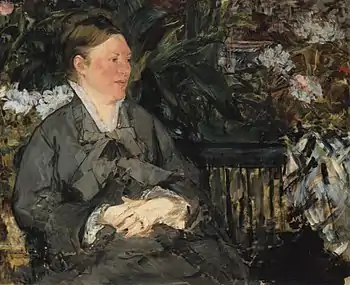In the Conservatory
In the Conservatory (French: Dans la serre) is an 1879 oil painting by Édouard Manet in the Alte Nationalgalerie, Berlin, depicting Manet's friends, a couple, in a conservatory. There is an ambiguity in the painting that has led art critics to characterize the couple's relationship in divergent ways.
| In the Conservatory | |
|---|---|
 | |
| Artist | Édouard Manet |
| Year | 1878–9 |
| Medium | Oil on canvas |
| Dimensions | 115 cm × 150 cm (45.3 in × 59.1 in) |
| Location | Alte Nationalgalerie, Berlin |
Description
The setting is a conservatory at 70 Rue d'Amsterdam in Paris, then owned by painter Georg von Rosen and which Manet used as a studio for nine months in 1878 and 1879.[1] Such a conservatory may have been more than a greenhouse; French painter Alix-Louise Enault's Consolation depicted the Parisian conservatory as a "luxuriously decorated and intimate locale—a secluded indoor area conducive to private rendezvous".[2] At first glance, we see a double portrait of a fashionable and attractive couple of some social rank. They are Manet's friends, the Guillemets, who owned a clothing shop. Their married status is conveyed by their rings, and the proximity of their hands is the nearest hint of intimacy. The woman becomes the focus of the portrait, however, being more prominently placed and colourfully dressed. Their physical separation—with the husband Jules slouching in dark clothing behind the bench—their lack of engagement with the viewer, and their abstract gazes create a sense of detachment, which has been the primary theme in modern criticism of the work.[3]
The interplay of lines formally defines the work. The woman has an erect posture echoed by the vertical slats of the bench, and the man, though leaning forward, does not break that vertical. The bench continues off the right side, reinforcing the horizontal and the separation of foreground and background. The diagonal pleats on the woman's dress provide some relief from the linearity of the composition.
Since the painting's exhibition, critics have interpreted the couple's relationship diversely. Huysmans called the subjects "marvelously detached from the envelope of green surrounding them".[4] As Collins summarizes:
John Richardson, for example, called the figures 'stiff,' whereas the critic Castagnary, a contemporary of Manet's, wrote that 'nothing [could be] more natural than the attitudes.' The critic Banville has M. Guillemet staring at the rich moire silk of his wife's skirt; Duret has him chatting with her. Huysmans described Mme Guillemet as a 'lively flirt,' whereas another critic called her 'sulky.' George Heard Hamilton referred to a 'strange tension' reminiscent of The Balcony. And, finally, in Art Forum a feminist art critic has discovered in Mme Guillemet's 'positively recalcitrant' independence from her husband a 'radicalized female imagery.'[2]
The painting was exhibited in the 1879 Paris Salon and was regarded as surprisingly conservative for Manet. Jules-Antoine Castagnary wrote, with tongue in cheek, "But what is this? Face and hands more carefully drawn than usual: is Manet making concessions to the public?"[5]—and said it portrayed "the elegance of fashionable life".[1]
Manet's Chez le Père Lathuille (see Gallery), having similar subjects and painted later in the same year, may be seen as a companion to In the Conservatory. It was not included in the 1879 Salon.[2]
Provenance
Jean-Baptiste Faure bought In the Conservatory from Manet, along with three other paintings, for the "paltry sum" of 11,000 francs.[6] In 1896 the German Nationalgalerie in Berlin purchased it, becoming the first museum anywhere to have purchased a Manet.[7]
In 1945 by the end of the Second World War In the Conservatory was among the objects evacuated from the German National Gallery and the Berlin State Museums and put for safekeeping in a mine in Merkers. After the war the picture was discovered and secured by the Monuments Men. Its salvage was documented in several photographs which show soldiers from the U.S. Army posing with Manet’s painting in the mine in Merkers. These photographs have gained iconographic status over the years and are often falsely[8] used as an illustration of Nazi looted art in prestigious publications like the Deutsche Welle,[9] The Washington Post,[10] The New York Times[11] and even in academic papers.[12]
Gallery
 Manet, Chez le Père Lathuille (1879)
Manet, Chez le Père Lathuille (1879) A portrait of Manet's wife, Suzanne, in a similar setting and also from 1879
A portrait of Manet's wife, Suzanne, in a similar setting and also from 1879 The caricaturist Morel-Retz (pseudonym "Stop") published this caricature of In the Conservatory in Journal amusant (May 17, 1879) with the caption "An innocent young person cornered in the conservatory by an infamous seducer"[2]
The caricaturist Morel-Retz (pseudonym "Stop") published this caricature of In the Conservatory in Journal amusant (May 17, 1879) with the caption "An innocent young person cornered in the conservatory by an infamous seducer"[2] The painting was brought along with other pictures from the German National Gallery to a mine to protect it from the bomb war in World War II. This 1945 photograph shows US soldiers with the painting in the Merkers salt mine.
The painting was brought along with other pictures from the German National Gallery to a mine to protect it from the bomb war in World War II. This 1945 photograph shows US soldiers with the painting in the Merkers salt mine.
Notes
- Herbert, R. L. (1991). Impressionism: Art, Leisure, and Parisian Society. New Haven, Conn: Yale University Press; p. 182. ISBN 0300050836
- Collins, Bradley. "Manet's 'In the Conservatory' and 'Chez Le Père Lathuille.'" Art Journal, vol. 45, no. 1, 1985, pp. 59–66. JSTOR 776876
- Lehmbeck, Leah Rosenblatt (2007). Edouard Manet's Portraits of Women. New York: New York University/ProQuest. pp. 107–109, at length in Crary. ISBN 0549099662.
- Lehmbeck, Leah Rosenblatt (2007). Edouard Manet's Portraits of Women. New York: New York University/ProQuest. pp. 109, fn 85. ISBN 0549099662.
- Crary, Jonathan (2001). Suspensions of Perception: Attention, Spectacle, and Modern Culture. Cambridge, MA: MIT Press. p. 90. ISBN 0262531992.
- Brombert, Beth Archer (1997). Edouard Manet: Rebel in a Frock Coat. Chicago: University of Chicago Press. p. 450. ISBN 0226075443.
- Demandt, Philipp (2015). Schule des Sehens. Die Nationalgalerie und die Moderne. Berlin: Hirmer. p. 14. ISBN 978-3-7774-2343-2. The previous decade the Metropolitan Museum of Art in New York had received two Manets as gifts.
- Dr. Bradsher, Greg (25 June 2014). "Wintergarden by Manet was NOT Looted by the Nazis". Retrieved 24 April 2017.
- Deutsche Welle (21 November 2013). "Affäre-Gurlitt: Zentralrat der Juden klagt über Umgang mit NS-Raubkunst". Deutsche Welle. Retrieved 24 April 2017.
- Fisher Sullam, Susan (19 June 2014). "Monuments Men: A Baltimore writer learns her father helped in the search for Nazi plunder". The Washington Post. Retrieved 24 April 2017.
- Mashberg, Tom (5 May 2015). "Returning the Spoils of World War II, Taken by Americans". The New York Times. Retrieved 24 April 2017.
- Meier, Oliver; Feller, Michael; Christ, Stefanie (2017). Der Gurlitt-Komplex. Bern und die Raubkunst. Zurich: Chronos. p. 76. ISBN 978-3-0340-1357-4.
References
- Brombert, Beth Archer (1997). Edouard Manet: Rebel in a Frock Coat. University of Chicago Press. ISBN 0226075443.
- Crary, Jonathan (2001). Suspensions of Perception: Attention, Spectacle, and Modern Culture. MIT Press. ISBN 0262531992.
- Lehmbeck, Leah Rosenblatt (2007). Edouard Manet's Portraits of Women. New York University/ProQuest. ISBN 0549099662.
External links
- In the Conservatory gigapixel image at the Google Art Project
- smARThistory: Manet's In the Conservatory
- ArtSleuth : Manet's In the Conservatory video analysis